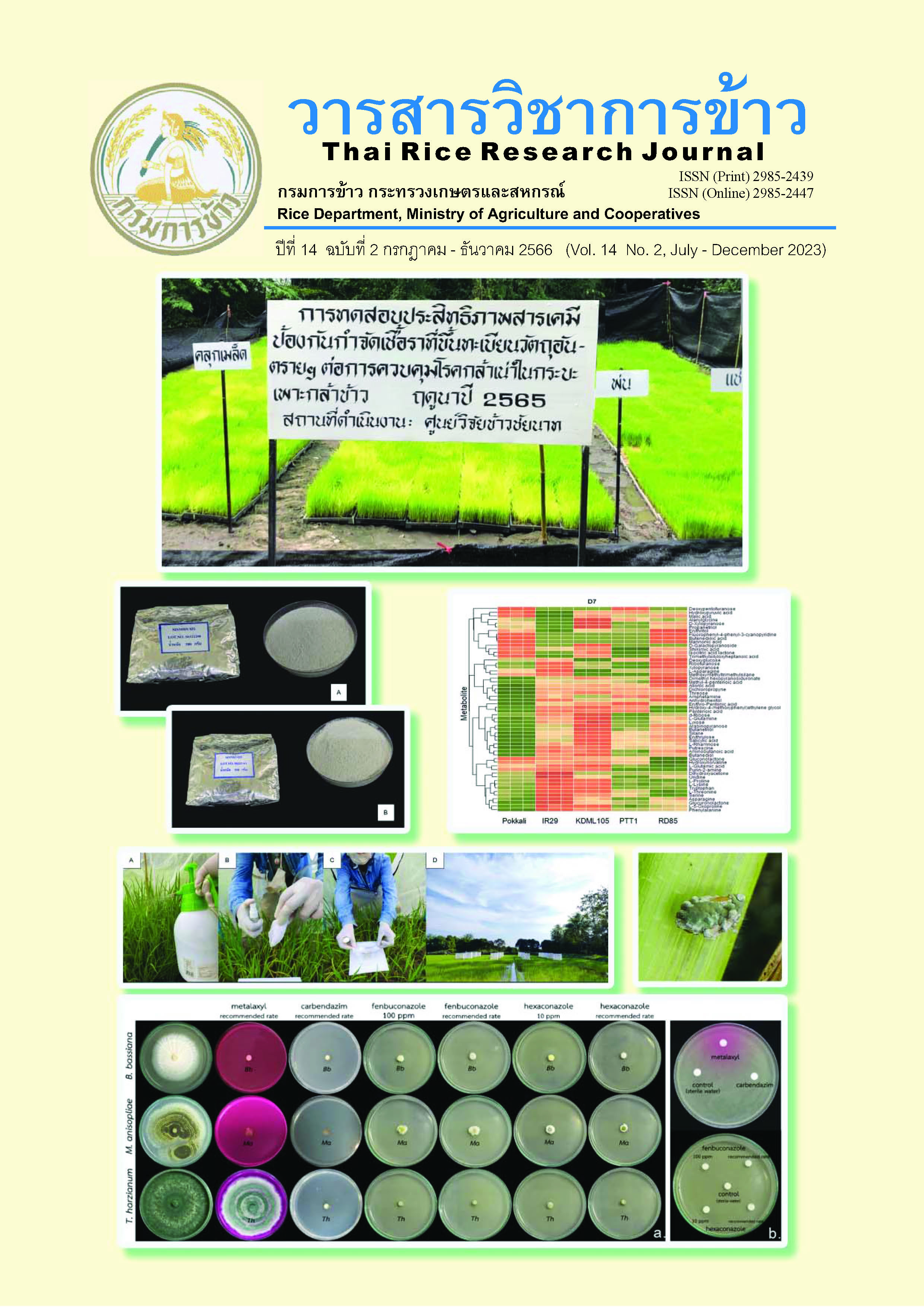Efficacy of Fungicides to Control Rice Seedling Rot Disease and Effects on Antagonistic Microorganisms
Main Article Content
Abstract
Rice cultivation with a seedling transplanting machine is often destroyed by pathogenic fungi such as Curvularia lunata, Bipolaris oryzae and Fusarium spp. Rice seedlings are infected with fungi, resulting in abnormal seedlings that are not suitable for transplanting. This research aimed to test the effective fungicides registered by the Department of Agriculture to control rice seedling rot disease, for proper application and to investigate the effects of fungicides on antagonistic microorganisms. In 2022, fungicide efficacy tests were conducted at the Chai Nat Rice Research Center under greenhouse and rice seedling nursery conditions. The results found that seeds were soaked, coated by fungicides for 12 hours, sprayed fungicides on the seeds with fenbuconazole 24% W/V SC 8- 40 ml per 20 liters of water and hexaconazole 5% W/V SC 4- 20 ml per 20 liters of water could reduce the disease incidence 71.55-83.88%. Both fungicides could be used as alternative fungicides to replace carbendazim 50% WP for further recommendation to farmers. Study effects of fungicides on antagonistic microorganisms on PDA and NA, the results showed that fenbuconazole 24% W/V SC, hexaconazole 5% W/V SC, carbendazim 50% SC and metalaxyl 35% DS effects on mycelial growth of Beauveria bassiana, Metarhizium anisopliae and Trichoderma harzianum. Metalaxyl 35% DS also affects the sporulation of T. harzianum. All fungicides did not affect the growth of Bacillus amyloliquefaciens.
Article Details
References
กนกกร นาคอ้น, ชัยณรงค์ รัตนกรีฑากุล และรัติยา พงศ์พิสุทธา. 2560. การตอบสนองต่อสารเคมีกำจัดโรคพืชของเชื้อรา Trichoderma spp. ที่แยกได้จากพื้นที่ปลูกทุเรียน จังหวัดจันทบุรี. สืบค้นจาก: https://kukr.lib.ku.ac.th/proceedings/KUCON/searchdetail/result/382780. (26 มกราคม 2566)
กรมการข้าว. 2559. องค์ความรู้เรื่องข้าว. สืบค้นจาก: http://www.ricethailand.go.th/rkb3. (26 มกราคม 2566)
กลุ่มศูนย์วิจัยข้าวภาคเหนือตอนล่าง. 2560. เทคโนโลยีการผลิตข้าวนาชลประทานในเขตภาคเหนือตอนล่าง ศูนย์วิจัยข้าวพิษณุโลก. โฟกัสพริ้นติ้ง จำกัด, จ.พิษณุโลก. 304 หน้า.
ดวงกมล บุญช่วย. 2562. การจัดการโรคข้าวที่สำคัญในกระบะเพาะกล้า เพื่อเพิ่มประสิทธิภาพการผลิตเมล็ดพันธุ์ข้าว. เอกสารประกอบการประเมินบุคคลเพื่อแต่งตั้งให้ดำรงตำแหน่งนักวิชาการเกษตรชำนาญการพิเศษ. ศูนย์วิจัยข้าวชัยนาท กองวิจัยและพัฒนาข้าว กรมการข้าว, กรุงเทพฯ. 96 หน้า.
ดวงกมล บุญช่วย, ชณินพัฒน์ ทองรอด, จิราพร แจ้งประดิษฐ์ และวันพร เข็มมุกด์. 2565. ประสิทธิภาพสารป้องกันกำจัดเชื้อราต่อการควบคุมโรคกล้าเน่าในกระบะเพาะกล้าข้าว. หน้า 147-148. ใน: การประชุมวิชาการอารักขาพืชแห่งชาติ ครั้งที่ 15. 22-24 พฤศจิกายน 2565. โรงแรมรามาการ์เด้นส์, กรุงเทพฯ.
ดวงกมล บุญช่วย, วิไล ปาละวิสุทธิ์ และชญานิศา สีพรม. 2560. สถานการณ์โรคข้าวที่สำคัญในกระบะเพาะกล้าในเขตชลประทานและการป้องกันกำจัด. หน้า 82-95. ใน: การประชุมวิชาการอารักขาพืช ครั้งที่ 13. 21-23 พฤศจิกายน 2560. โรงแรมเรือรัษฎา, จ.ตรัง.
ธิดา เดชฮวบ. 2559. สารเคมีที่ใช้ป้องกันกำจัดโรคพืช. เอเชียดิจิตอลการพิมพ์จำกัด, กรุงเทพฯ. 19 หน้า.
พยอม โคเบลลี่ และธีรดา หวังสมบูรณ์ดี. 2562. สารป้องกันกำจัดศัตรูพืชที่เป็นสารขัดขวางการทำงานของต่อมไร้ท่อ: ผลกระทบต่อผู้ส่งออกข้าวไทย. วารสารวิชาการข้าว 10(1): 108-119.
วิไล ปาละสุทธิ์, จิตติชัย อนาวงษ์, ชโลทร หลิมเจริญ, อดุลย์ กฤษวดี และนริศรา จำรูญวงษ์. 2555. การเพิ่มประสิทธิภาพการผลิตเมล็ดพันธุ์ข้าวโดยใช้เครื่องปักดำ. หน้า 439-442. ใน: เอกสารประกอบการประชุมวิชาการข้าวแห่งชาติ ครั้งที่ 2. 21-23 ธันวาคม 2555. สวิสโซเทลเลอคองคอร์ด, กรุงเทพฯ.
ศิริลักษณ์ ใจบุญทา, รัฐพล ใจคำ, อัญชลี ตาคำ, นุจรินทร์ จังขันธ์ และปิยะพันธ์ ศรีคุ้ม. 2562. ประสิทธิภาพของเชื้อราปฏิปักษ์ และสารเคมีกำจัดเชื้อราในการยับยั้งโรคกล้าเน่าของข้าวจาปอนิกาในห้องปฏิบัติการ. หน้า 27. ใน: เอกสารประกอบการประชุมวิชาการข้าว ประจำปี 2562. 12-13 มีนาคม 2562. โรงแรมมารวยการ์เด้น, กรุงเทพฯ.
สุณีรัตน์ สีมะเดื่อ, พรพิมล อธิปัญญาคม, ชนินทร ดวงสอาด และอภิรัชต์ สมฤทธิ์. 2554. ประสิทธิภาพของสารป้องกันกำจัดโรคพืชในการป้องกันกำจัดเชื้อรา Curvularia eragrostidis สาเหตุโรคพืช. หน้า 803-808. ใน: รายงานผลงานวิจัยประจำปี 2554 สำนักวิจัยพัฒนาการอารักขาพืช กรมวิชาการเกษตร. กรุงเทพฯ.
Adachi, N., T. Shoichi, I. Yasuhiro and A. Koji. 2012. Control of bacterial seedling rot and seedling blight of rice by bacteriophage. Plant Disease 96(7): 1033-1036.
Akter, S., M.A. Latif, A.T. Mia, T.H. Ansari, M.T. Islam and M.Y. Rafi. 2013. Efficacy of fungicides against grain spot disease in rice (Oryza sativa). Life Science Journal 10(4): 3005-3008.
Fungicide resistance action committee (FRAC). 2017. Action and mechanism of resistance. Available source: http://www.frac.info/expert-for. (January 26, 2023)
Kindo, D., R.K. Bhagat and P.K. Tiwari. 2015. Efficacy of fungicides for the management of sheath rot disease in rice under in vitro and in vivo conditions. Oryza 52(3): 227-230
Kumar, M.P., D.S. Gowda, R. Moudgal, N.K. Kumar, K.P. Gowda and K. Vishwanath. 2013. Impact of fungicides on rice production in India. Fungicidesshowcases of integrated plant disease management from around the world pp.77-98.
Lewis, K.A., J. Tzilivakis, D. Warner and A. Green. 2016. An international database for pesticide risk assessments and management. Human and Ecological Risk Assessment: An International Journal 22(4): 1050-1064.
National Center for Biotechnology Information (NCBI). 2023. PubChem compound summary for CID86138, fenbuconazole. Available source: https://pubchem.ncbi.nlm.nih.gov/compound/Fenbuconazole. (February 9, 2023)
Ons, L., D. Bylemans, K. Thevissen and B.P.A. Cammue. 2020. Combining biocontrol agents with chemical fungicides for integrated plant fungal disease control. Available source: https://doi.org/10.3390/microorganisms8121930. (February 9, 2023)
Prakash, G., U.D. Singh, P. Sharma and R.T.P. Pandian. 2013. Evaluation of pesticides against rice sheath blight caused by Rhizoctonia solani. Indian Phytopath 66(4): 351-355
Vincent, J.M. 1927. Distortion of fungi hyphae in the presence of certain inhibitors. Available source: https://www.nature.com/articles/159850b0. (February 9, 2023)
Yilmaz, B., H. Terekeci, S. Sandal and F. Kelestimur. 2012. Endocrine disrupting chemicals: exposure, effects on human health, mechanism of action, models for testing and strategies for prevention. Available source: https://pubmed.ncbi.nlm.nih.gov/31792807. (February 9, 2023)
